
According to apocrypha, as well as Christian and Islamic tradition, Saint Anne was the mother of Mary, the wife of Joachim and the maternal grandmother of Jesus. Mary's mother is not named in the Bible's canonical gospels. In writing, Anne's name and that of her husband Joachim come only from New Testament apocrypha, of which the Gospel of James seems to be the earliest that mentions them. The mother of Mary is mentioned but not named in the Quran.

Domenico di Tommaso Curradi di Doffo Bigordi, professionally known as Domenico Ghirlandaio, also spelt as Ghirlandajo, was an Italian Renaissance painter born in Florence. Ghirlandaio was part of the so-called "third generation" of the Florentine Renaissance, along with Verrocchio, the Pollaiolo brothers and Sandro Botticelli. Ghirlandaio led a large and efficient workshop that included his brothers Davide Ghirlandaio and Benedetto Ghirlandaio, his brother-in-law Bastiano Mainardi from San Gimignano, and later his son Ridolfo Ghirlandaio. Many apprentices passed through Ghirlandaio's workshop, including the famous Michelangelo. His particular talent lay in his ability to posit depictions of contemporary life and portraits of contemporary people within the context of religious narratives, bringing him great popularity and many large commissions.

The Annunciation, also referred to as the Annunciation to the Blessed Virgin Mary, the Annunciation of Our Lady, or the Annunciation of the Lord, is, according to the Gospel of Luke, the announcement by the archangel Gabriel to Mary that she would conceive and bear a son through a virgin birth and become the mother of Jesus Christ, the Christian Messiah and Son of God, marking the Incarnation. Gabriel told Mary to name her son Immanuel, meaning "God is with us".

The Latin Gospel of Pseudo-Matthew is a part of the New Testament apocrypha. In antiquity, the text was called The Book About the Origin of the Blessed Mary and the Childhood of the Savior. Pseudo-Matthew is one of a genre of "Infancy gospels" that seek to fill out the details of the life of Jesus of Nazareth up to the age of 12, which are briefly given in the Gospels of Matthew and Luke. In the West, it was the dominant source for pictorial cycles of the Life of Mary, especially before the Late Middle Ages.

Florentine painting or the Florentine School refers to artists in, from, or influenced by the naturalistic style developed in Florence in the 14th century, largely through the efforts of Giotto di Bondone, and in the 15th century the leading school of Western painting. Some of the best known painters of the earlier Florentine School are Fra Angelico, Botticelli, Filippo Lippi, the Ghirlandaio family, Masolino, and Masaccio.

The Sassetti Chapel is a chapel in the basilica of Santa Trinita in Florence, Italy. It is especially notable for its frescoes of the Stories of St. Francis, considered Domenico Ghirlandaio's masterwork.

Italian Renaissance painting is the painting of the period beginning in the late 13th century and flourishing from the early 15th to late 16th centuries, occurring in the Italian Peninsula, which was at that time divided into many political states, some independent but others controlled by external powers. The painters of Renaissance Italy, although often attached to particular courts and with loyalties to particular towns, nonetheless wandered the length and breadth of Italy, often occupying a diplomatic status and disseminating artistic and philosophical ideas.

This article about the development of themes in Italian Renaissance painting is an extension to the article Italian Renaissance painting, for which it provides additional pictures with commentary. The works encompassed are from Giotto in the early 14th century to Michelangelo's Last Judgement of the 1530s.
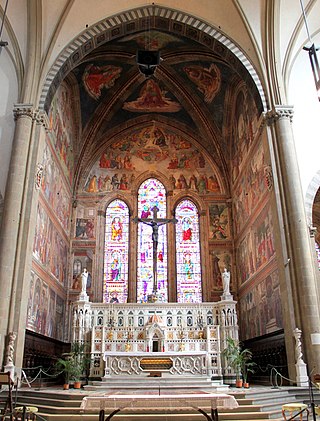
The Tornabuoni Chapel is the main chapel in the church of Santa Maria Novella, Florence, Italy. It is famous for the extensive and well-preserved fresco cycle on its walls, one of the most complete in the city, which was created by Domenico Ghirlandaio and his workshop between 1485 and 1490.
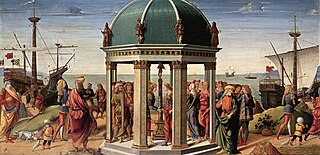
Biagio d’Antonio Tucci was an Italian Renaissance painter active in Florence, Faenza and Rome.

The Nativity of Jesus has been a major subject of Christian art since the 4th century.

The Life of the Virgin, showing narrative scenes from the life of Mary, the mother of Jesus, is a common subject for pictorial cycles in Christian art, often complementing, or forming part of, a cycle on the Life of Christ. In both cases the number of scenes shown varies greatly with the space available. Works may be in any medium: frescoed church walls and series of old master prints have many of the fullest cycles, but panel painting, stained glass, illuminated manuscripts, tapestries, stone sculptures and ivory carvings have many examples.
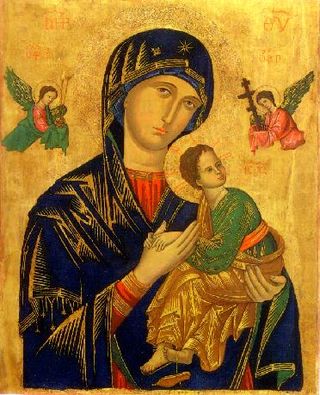
Mary has been one of the major subjects of Western Art for centuries. There is an enormous quantity of Marian art in the Catholic Church, covering both devotional subjects such as the Virgin and Child and a range of narrative subjects from the Life of the Virgin, often arranged in cycles. Most medieval painters, and from the Reformation to about 1800 most from Catholic countries, have produced works, including old masters such as Michelangelo and Botticelli.

The life of Christ as a narrative cycle in Christian art comprises a number of different subjects showing events from the life of Jesus on Earth. They are distinguished from the many other subjects in art showing the eternal life of Christ, such as Christ in Majesty, and also many types of portrait or devotional subjects without a narrative element.
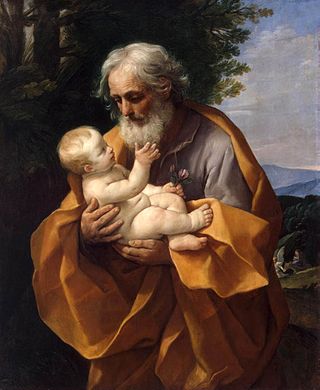
Joseph was a 1st-century Jewish man of Nazareth who, according to the canonical Gospels, was married to Mary, the mother of Jesus, and was the legal father of Jesus.

The Espousals of the Blessed Virgin Mary or Marriage of the Virgin Mary is a Christian feast is celebrated by certain parts of the Roman Catholic Church such as the Oblates of Saint Joseph. It was formerly generally observed on January 23, but was removed from many local calendars by the Sacred Congregation of Rites.
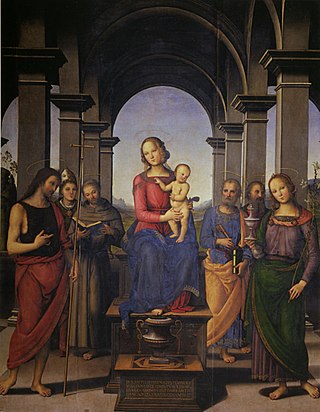
The Fano Altarpiece is a painting by the Italian Renaissance artist Pietro Perugino, executed in 1497, and housed in the church of Santa Maria Nuova, Fano, central Italy. It also includes a lunette with a Pietà and several predella panels.

The Annunciation has been one of the most frequent subjects of Christian art. Depictions of the Annunciation go back to early Christianity, with the Priscilla catacomb in Rome including the oldest known fresco of the Annunciation, dating to the 4th century.

The Marriage of the Virgin or also known as TheBetrothal of the Virgin, is a c. 1420–1430 oil on oak painting by Robert Campin. The painting was intended to be a metaphor, primarily focused on the transition from the Old to the New Testament, which is expressed through iconography and disguised symbolism. It entered into the Spanish royal collection at El Escorial in 1584. It was later obtained by Prado Museum, where it continues to reside. This work by Robert Campin is one of his earliest and was previously attributed to Roger Van der Weyden.





























